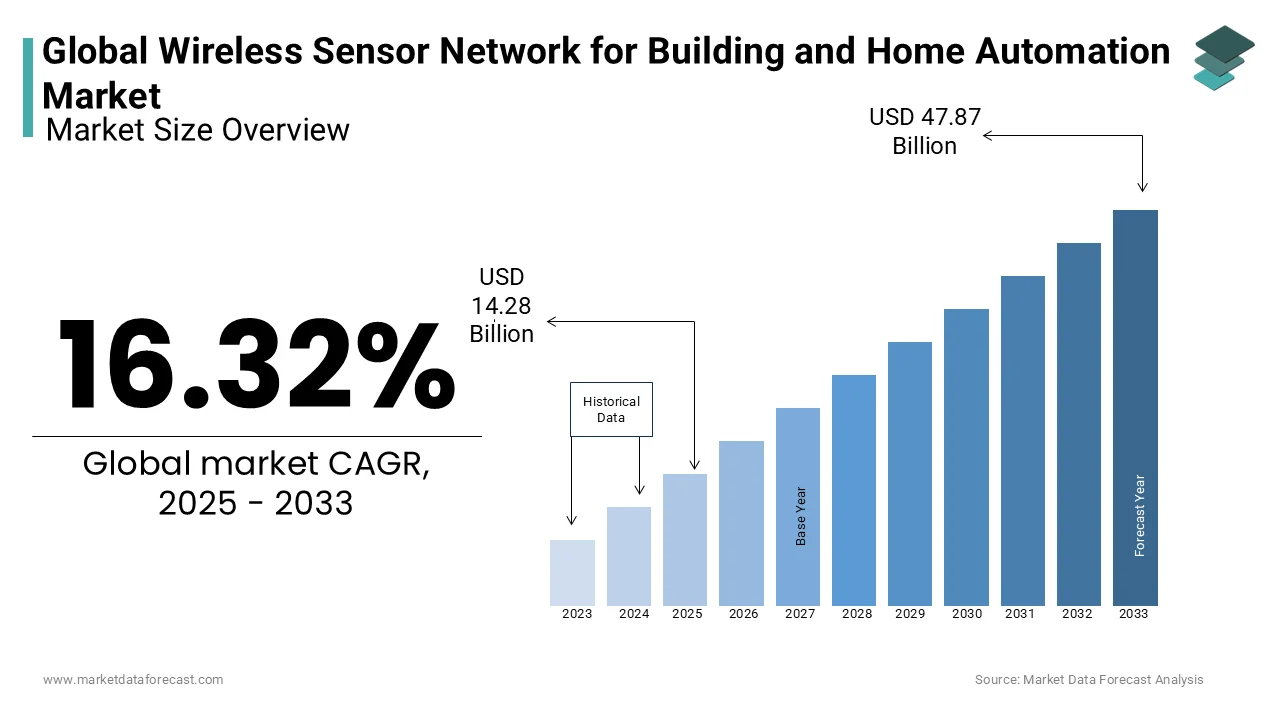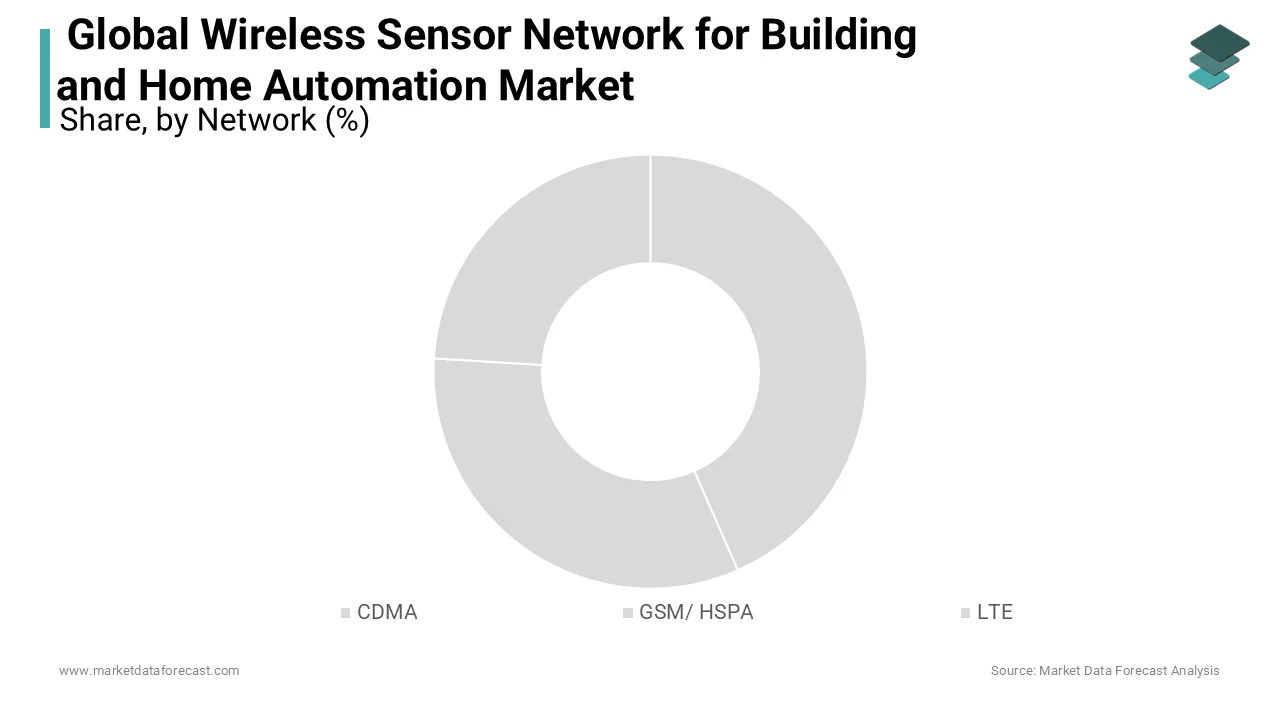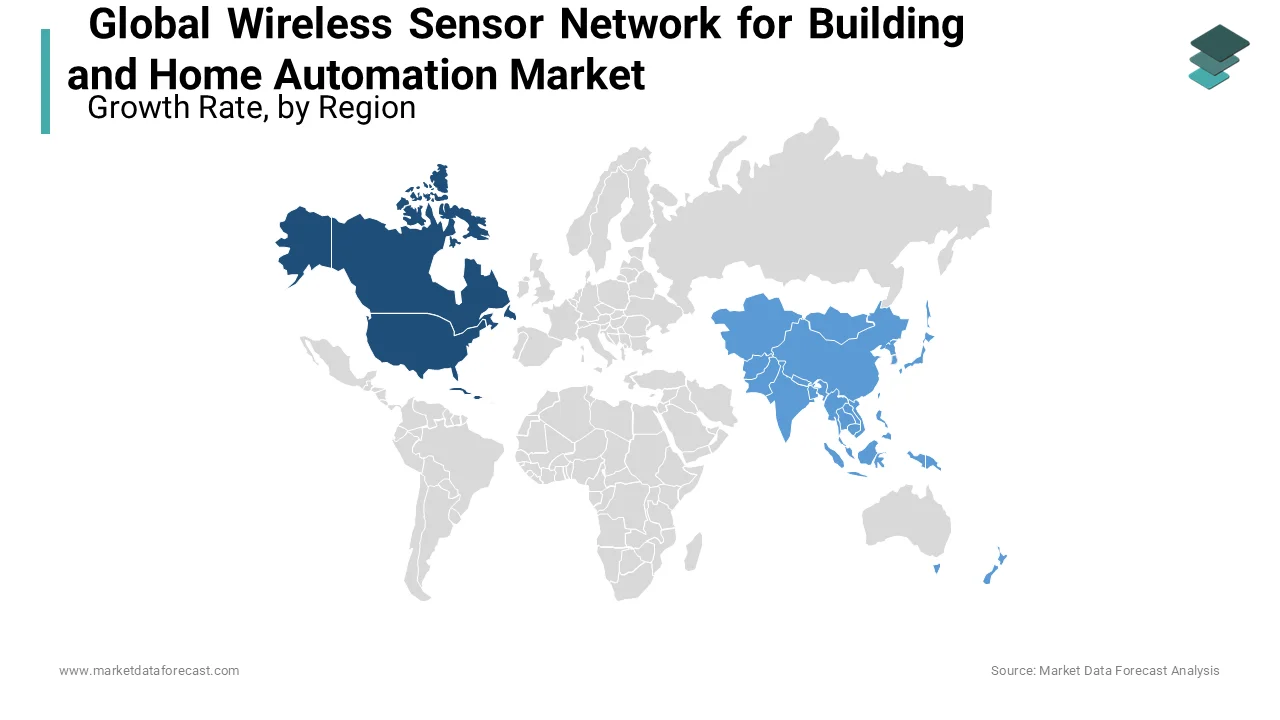Global Wireless Sensor Network for Building and Home Automation Market Size, Share, Trends, & Growth Forecast Report by Network (CDMA, GSM/ HSPA, LTE) Communication technology (ZigBee, z wave, Wi-Fi, Bluetooth), Application (lighting control, security and access control, entertainment control, other control), & Region, Industry Forecast From 2024 to 2033
Global Wireless Sensor Network for Building and Home Automation Market Size
The global wireless sensor network for building and home automation market was worth USD 12.28 billion in 2024. The global market is expected to reach USD 14.28 billion in 2025 and USD 47.87 billion by 2033, growing at a CAGR of 16.32% during the forecast period 2025 to 2033.

Wireless sensor networks improve the efficiency, safety, and comfort of buildings. A home automation and building wireless sensor network is a network built using various connectivity technologies and devices to enable seamless and endless connectivity to home automation and building devices. These networks connect building and home automation devices to connecting devices for remote operation.
MARKET DRIVERS
Wireless Sensor Network (WSN) is revolutionizing industrial monitoring and diagnostics where sensor networks have low-power, low-cost WSN monitoring points.
These networks include battery-powered motes that can quickly form a network, in which sensors communicate with each other wirelessly. Wireless sensor networks can be used for consumer applications such as home automation, PC peripherals, and remote controls.
Globally, the reduction in home automation costs and the increasing popularity of home automation systems in major markets are expected to continue to be key growth drivers during the forecast period. Wireless sensor networks are required to change the way correspondence happens in the actual world. Associations need ongoing permeability and insight for their authoritative and operational information to accomplish this new degree of effectiveness, exactness, and cost decrease. There are many applications of the wireless sensor network in robotics, such as advanced robotic sensing, multi-robot coordination, robot planning and navigation, and robot tracking. Using a network of wireless sensors helps emergency response robots understand conditions, such as monitoring electromagnetic fields, detecting wildfires and others.
MARKET RESTRAINTS
With the increase in connectivity technology, the rate of data intrusions is also increasing rapidly. As devices and connections continue to grow exponentially, data will become more crucial. Network platforms have only recently been developed and are not robust with security requirements. This is a major limitation for the development of the wireless sensor network market, as enterprise data security is important when developing analytics solutions for various specific vertical applications.
REPORT COVERAGE
|
REPORT METRIC |
DETAILS |
|
Market Size Available |
2024 to 2033 |
|
Base Year |
2024 |
|
Forecast Period |
2025 to 2033 |
|
CAGR |
16.32% |
|
Segments Covered |
By Network, Communication Technology, Application, and Region. |
|
Various Analyses Covered |
Global, Regional & Country Level Analysis, Segment-Level Analysis, DROC, PESTLE Analysis, Porter’s Five Forces Analysis, Competitive Landscape, Analyst Overview on Investment Opportunities |
|
Regions Covered |
North America, Europe, APAC, Latin America, Middle East & Africa |
|
Market Leaders Profiled |
Intel Corporation (US), ABB Ltd. (Switzerland), Texas Instruments Inc. (US), Huawei Investment & Holding Co., Ltd. (China), Cisco Systems Inc. (US), STMicroelectronics N.V. (Netherlands), TE Connectivity Ltd. (Switzerland), NXP Semiconductor N.V. (Netherlands), Dell Inc. (US), Hewlett Packard Enterprise Company (US), Robert Bosch GmbH (Germany), Advantech Co., Ltd. (Taiwan), Honeywell International Inc. (US), Broadcom Limited (US), Infineon Technologies AG (Germany), Emerson Electric Company (US), Analog Devices Inc. (US), Eurotech S.p.A (Italy), Invensense Inc. (US), Sensirion AG (Switzerland) and Others. |
SEGMENTAL ANALYSIS
By Network Insights
The global system for mobile communications (GSM) is a standard created by the European Telecommunications Standards Institute (ETSI) to portray the conventions for second-era (2G) computerized cell networks utilized by mobile phones like cell phones and tablets. Also, "long-term evolution", or "LTE", is the business language used to portray the specific kind of 4G that offers the quickest versatile Internet experience. So with an organization like Verizon's, you outwit the two universes with regards to remote information use: 4G and LTE.

By Communication Technology Insights
Zigbee is a remote innovation created as an open worldwide norm to meet the novel necessities of ease, low-power remote IoT organizations. The Zigbee standard works with the IEEE 802.15. 4 with standard actual radio determination and works in unlicensed groups including 2.4 GHz, 900 MHz and 868 MHz. Wi-Fi is a wireless networking technology that enables devices such as computers (laptops and desktops), mobile devices (smartphones and portable devices) and other equipment (printers and video cameras) to interact with the Internet. Bluetooth innovation is a short-range remote correspondence innovation to supplant links between electronic gadgets, permitting an individual to have a phone discussion through a headset, utilize a remote mouse, and synchronize data on the telephone. From a cell phone to a PC, all utilize a similar framework bit.
By Application Insights
The need for a higher level of security, activity monitoring, and access control has led to increased demand for WSNs. The mass adoption of building automation systems to increase energy efficiency and save energy and costs is also contributing to the growth of the WSN market for building automation.
REGIONAL ANALYSIS
North America was followed by Europe and Asia-Pacific as the second and third largest wireless sensor networking market for the home automation and building market. Geographically, North America has dominated the wireless sensor network for the home and building automation market, thanks to increased technology penetration and automation rate in such applications, a technology-informed population, a greater number of Internet users and a better network infrastructure in the region.

Asia-Pacific is expected to experience the fastest growth, due to the increasing penetration of technology and the development of network infrastructure in developing countries such as China and India in this region.
KEY MARKET PLAYERS
Companies playing a key role in the global wireless sensor network for building and home automation market include Intel Corporation (US), ABB Ltd. (Switzerland), Texas Instruments Inc. (US), Huawei Investment & Holding Co., Ltd (China), Cisco Systems Inc. (US), STMicroelectronics N.V. (Netherlands), TE Connectivity Ltd. (Switzerland), NXP Semiconductor N.V. (Netherlands), Dell Inc. (US), Hewlett Packard Enterprise Company (US), Robert Bosch GmbH (Germany), Advantech Co., Ltd. (Taiwan), Honeywell International Inc. (US), Broadcom Limited (US), Infineon Technologies AG (Germany), Emerson Electric Company (US), Analog Devices Inc. (US), Eurotech S.p.A (Italy), Invensense Inc. (US) and Sensirion AG (Switzerland).
RECENT HAPPENINGS IN THE MARKET
- ABB Technology Ventures' investment in Everactive, a technology company that produces self-powered wireless sensors, reflects ABB's ongoing commitment to delivering value to customers through innovation.
- Intel provides secure and scalable building blocks for industrial IoT solutions that bring intelligence to your operational assets and reveal insights from data. Built on open, standards-based solutions, Intel's vast ecosystem lets you choose the best applications with confidence. The results: potentially reduced maintenance costs, new business opportunities, and incredible productivity.
MARKET SEGMENTATION
This research report on the global wireless sensor network for the building and home automation market has been segmented and sub-segmented based on the network, communication technology, application, and region.
By Network
- CDMA
- GSM/ HSPA
- LTE
By Communication Technology
- Zigbee
- Z- wave
- Wi- fi
- Bluetooth
By Application
- Lighting Control
- Security And Access Control
- Entertainment Control
- Other Control
By Region
- North America
- Europe
- Asia Pacific
- Latin America
- The Middle East and Africa
Frequently Asked Questions
What are the main factors driving the growth of the Wireless Sensor Network for Building and Home Automation market globally?
The main factors include the rising adoption of smart home devices, increasing awareness of energy efficiency, advancements in IoT technology, and the growing need for security and surveillance systems in residential and commercial buildings.
What are the key applications of Wireless Sensor Networks in building and home automation?
Key applications include energy management, security and surveillance, HVAC (heating, ventilation, and air conditioning) control, lighting control, and smart appliances.
What are the technological advancements contributing to the growth of Wireless Sensor Networks in this market?
Technological advancements such as the development of low-power wide-area networks (LPWAN), integration of AI and machine learning for predictive maintenance and optimization, and improvements in battery technology are major contributors.
What role do government regulations play in the adoption of Wireless Sensor Networks for building and home automation?
Government regulations promoting energy efficiency and smart city initiatives are driving the adoption of WSNs. Policies and incentives aimed at reducing carbon footprints also support market growth.
Related Reports
Access the study in MULTIPLE FORMATS
Purchase options starting from $ 2500
Didn’t find what you’re looking for?
TALK TO OUR ANALYST TEAM
Need something within your budget?
NO WORRIES! WE GOT YOU COVERED!
Call us on: +1 888 702 9696 (U.S Toll Free)
Write to us: [email protected]